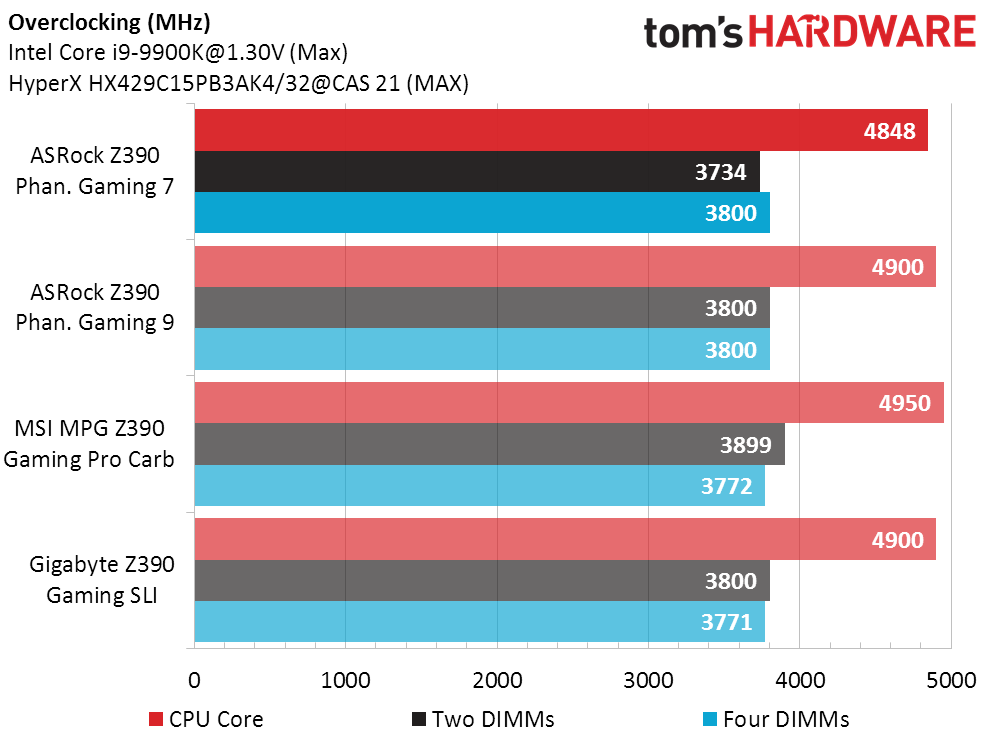ASRock Z390 Phantom Gaming 7 Motherboard Review: Fast Ethernet Slips Under $200
Why you can trust Tom's Hardware
Benchmark Results and Final Analysis
We disable any motherboard-specified CPU overclocks for our basic performance tests, and disable XMP since some boards would formerly re-enable those CPU overclocks when XMP was applied. All CPU-based power-saving features are enabled to achieve the best idle power readings throughout these tests.
Synthetic Benchmarks


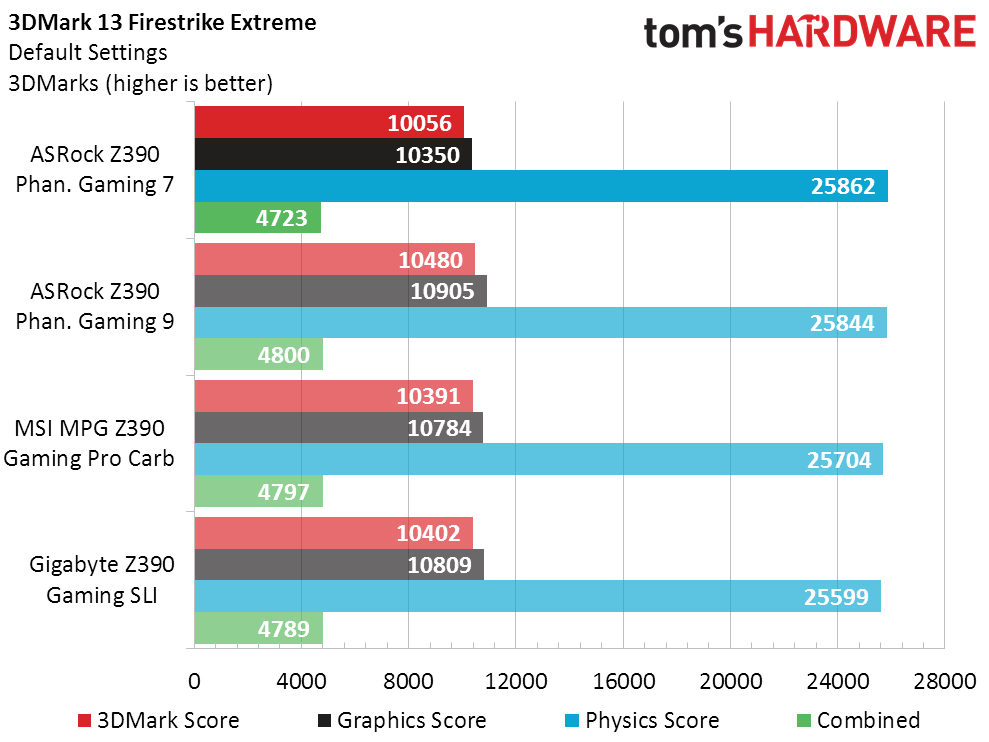


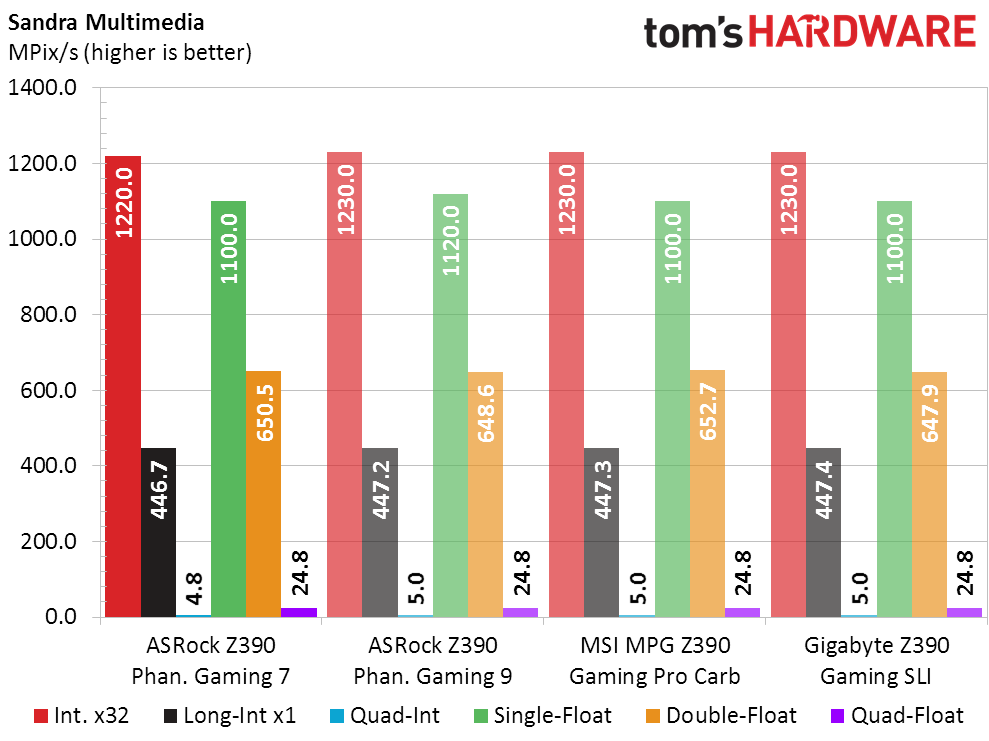


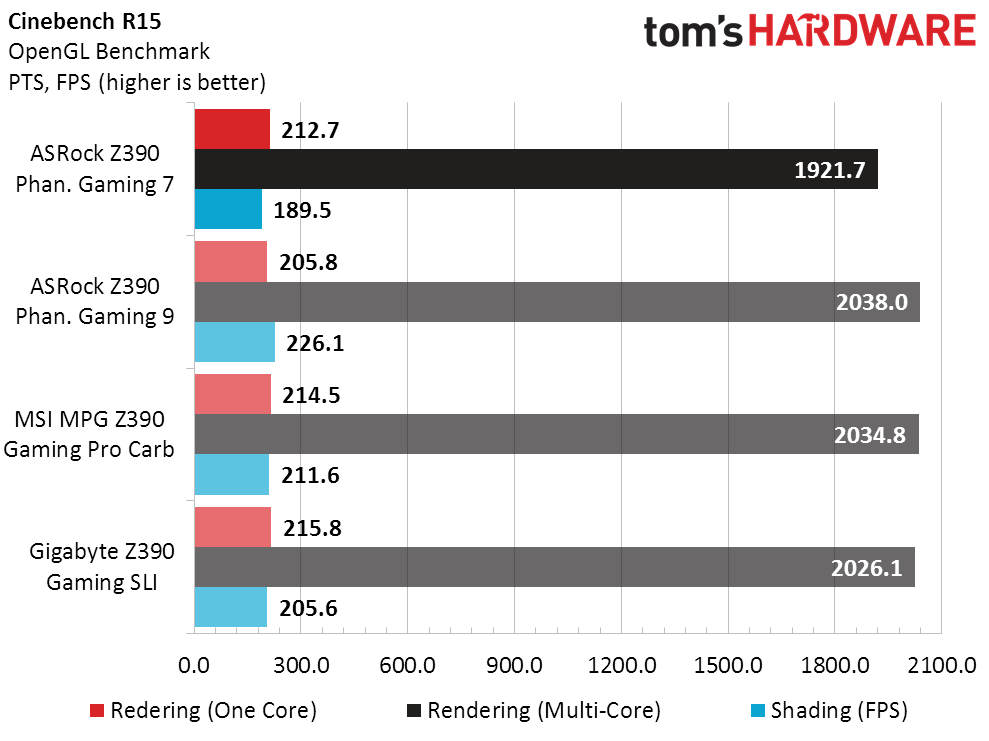

Both ASRock boards showed reduced graphics scores in 3DMark Firestrike, and the Z390 Phantom Gaming 7 performed poorly in PCMark Creative. We’d expect the performance deficit to show up in Compubench were this simply a matter of graphics performance, but the Z390 Phantom Gaming 7 leads the longest of those tests.
3D Games


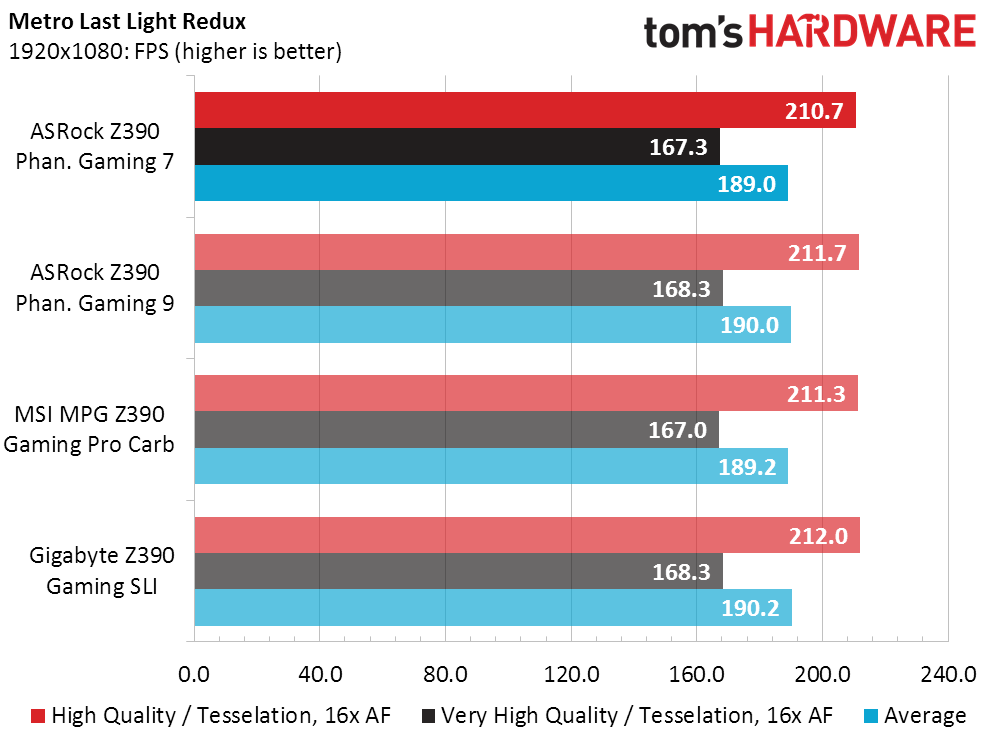

Proving that the Z390 Phantom Gaming 7 doesn’t suffer a graphics tests, it matches competing boards almost perfectly at the higher-quality settings of all four games. A small win at our lower Ashes setting is offset by a small loss at the lower setting of F1 2015.
Timed Applications
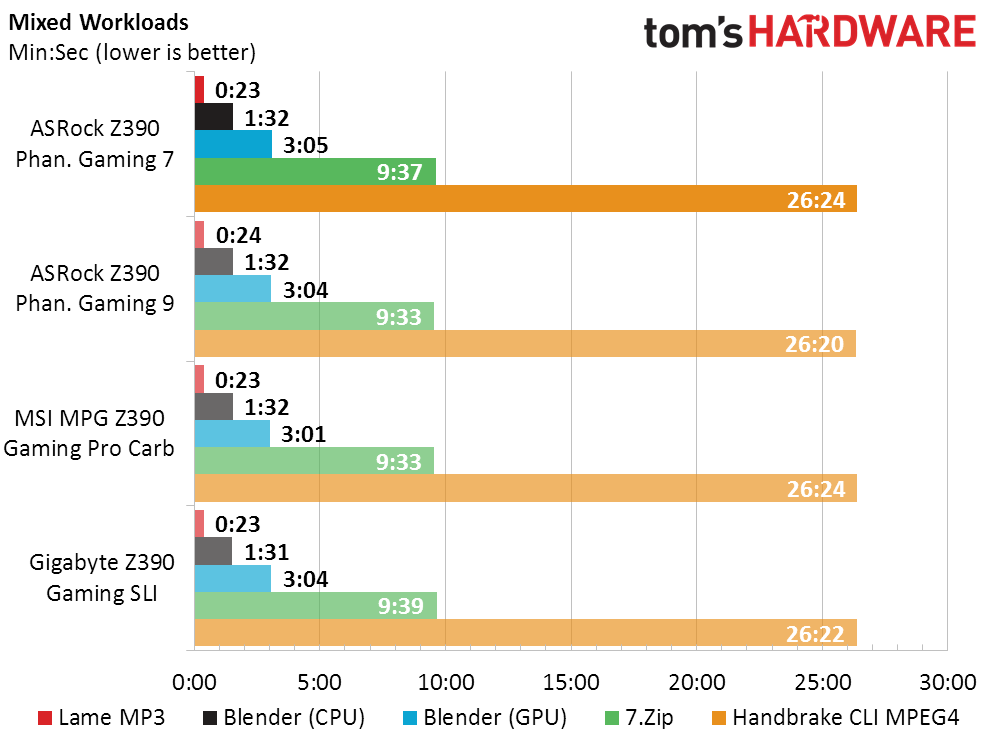


The Z390 Phantom Gaming 7’s most-serious performance deficits are in applications tested through PCMark. We considered that the problem might be within our installation, reinstalled our test image, and tried again, only be disappointed a second time.
Power, Heat & Efficiency
The Z390 Phantom Gaming 7’s power consumption is on par with comparable boards in the sub-$200 Z390 class.
Those moderate power numbers weren’t exactly helpful to the voltage regulator however: Probing the entire voltage regulator for hot spots, we found some scorching chokes behind the CPU socket, that were over 20 degrees hotter than the hottest spot of the Z390 Gaming SLI. The Z390 Phantom Gaming 9 and Z390 Gaming Pro Carbon's voltage regulator temperatures were checked with a thermistor at the same relative location, but we removed the data since that method is less able to pinpoint such anomalies.
The actual reading of the Z390 Phantom Gaming 7’s hottest choke was 126 degrees C, and it was surrounded by a few other chokes that were only a few degrees cooler: We had to reduce the room temperature to 18 degrees just to keep the board running long enough to get that measurement. Thermal protection for MOSFETs eventually kicked in as these chokes heated surrounding components, but that process took long enough that it occurred after the choke temperature had appeared to quit climbing. Our default configuration relies only on the draft of our liquid cooling systems fan to cool the voltage regulator however, and simply putting more airflow (an extra fan) closer to the Z390 Phantom Gaming 7’s voltage regulator solves the issue.
Get Tom's Hardware's best news and in-depth reviews, straight to your inbox.
Percent-based scoring in today’s review uses the average of all seventeen Z390 boards we’ve reviewed. The Z390 Phantom Gaming 7’s 1.7% below-average performance combines with is 2% above-average power consumption to produce a 3.7% below-average efficiency rating.
Overclocking
We’ve added a fan over the voltage regulator of every Z390 board during our overclocking analysis, as overheated voltage regulators have been a problem since the Core i9-9900K’s introduction. That simple solution has resolved the thermal issue of even the hottest boards, yet it didn’t resolve the Z390 Phantom Gaming 7’s lower-than-average overclock. We know that nobody’s willing to completely ignore the value of a board’s features if it comes up a mere 102 MHz short of a top rating, but a loss is still a loss.
On the other hand, the Z390 Phantom Gaming 7 did a solid job of pushing our DDR4-2933 test samples to either 3733 (2-DIMM) or 3800 (4-DIMM) data rates, and even edged out other sub-$200 boards in overclocked memory bandwidth.
Final Analysis
Value seekers are always discussing “bang for the buck,” so we always include a performance-per-dollar chart that serves as little more than entertainment when onboard features are what buyers are really paying for. The Z390 Phantom Gaming 7 and its Phantom Gaming 9 sibling score lowest here, because the 2.5GbE controller adds around $30 to both prices.
Having said that, if we wanted a 2.5GbE controller onboard we’d just pony up the extra cash for the Z390 Phantom Gaming 9. It’s a far better board overall, with better features such as an integrated Wi-Fi controller and true 10Gb/s USB 3.1 Gen2 front-panel header, and none of the heat alarms noticed in the Gaming 7. We’d call that $25 well spent.
If the $25 difference caused us to forgo 2.5GbE, we’d jump straight down to Gigabyte’s Z390 Gaming SLI for its better overclocks and lower temps, as well as its lack of PCIe pathway sharing.
Image Credits: Tom's Hardware
MORE: Best Motherboards
MORE: How To Choose A Motherboard
MORE: All Motherboard Content
-
g-unit1111 I really like this board and can't wait to see the review of the X570 version. The one trend that I do not like is the giant M2 covers, I feel like that could get really cumbersome in the long run. But this does look like a solid product.Reply -
B99RUO I'm not 100% sure but this one looks like yet another lie from mobo manufacturers. is this a proper 10 phase power board? With temps like that i seriously doubt it. It looks like the classic doubled components phases. This should be advertised as 4+2. That explains the poor O/C (that is a PRO feature) and the huge VRM temps (vrm cooling is another PRO feature). Led's are not a PRO feature. Apart from the post code .... and 100+ deg on the vrm will make that post code light up often enough ...Reply
I'm not 100% sure on the phases as i can't find a clear pcb pic anywhere but judging by the Phantom series of boards (all with crappy vrm, in no way PRO) and the huge temperatures it pulls, this is an entry level 4+2 phase board, good for a maximum of six cores and preferably no OC ...
It's place in ASrock's lineup suggest the same thing, average to entry level board masked up with LED's and 2 WIFI ants
No way is this a value proposition when for around 30-45USD more you can get the Z390 Taichi (not the ultimate) and that there is a proper board ...*as per pricing in my country -
Crashman Reply
Phase doubling wouldn't explain why the chokes were so hot, because those are on the other side of the MOSFETs.B99RUO said:I'm not 100% sure but this one looks like yet another lie from mobo manufacturers. is this a proper 10 phase power board? With temps like that i seriously doubt it. It looks like the classic doubled components phases. This should be advertised as 4+2. That explains the poor O/C (that is a PRO feature) and the huge VRM temps (vrm cooling is another PRO feature). Led's are not a PRO feature. Apart from the post code .... and 100+ deg on the vrm will make that post code light up often enough ...
I'm not 100% sure on the phases as i can't find a clear pcb pic anywhere but judging by the Phantom series of boards (all with crappy vrm, in no way PRO) and the huge temperatures it pulls, this is an entry level 4+2 phase board, good for a maximum of six cores and preferably no OC ...
It's place in ASrock's lineup suggest the same thing, average to entry level board masked up with LED's and 2 WIFI ants
No way is this a value proposition when for around 30-45USD more you can get the Z390 Taichi (not the ultimate) and that there is a proper board ...*as per pricing in my country



